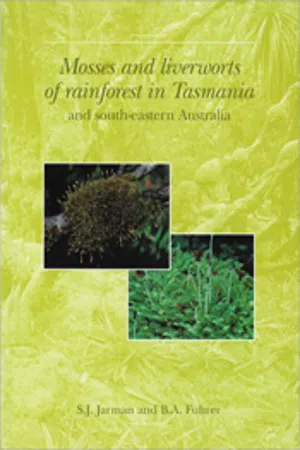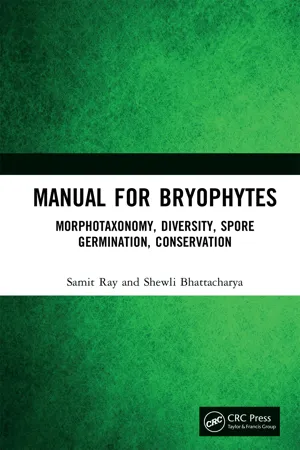Bryophytes
Bryophytes are non-vascular plants that include mosses, liverworts, and hornworts. They are small, simple plants that lack true roots, stems, and leaves. Bryophytes play important ecological roles, such as soil stabilization and moisture retention, and are often found in damp environments. They also have a significant historical importance as they were among the earliest land plants to evolve.
7 Key excerpts on "Bryophytes"
- SJ Jarman, BA Fuhrer(Authors)
- 1995(Publication Date)
- CSIRO PUBLISHING(Publisher)
...1 A general introduction to Bryophytes Character and occurrence Bryophytes are the plants popularly known as mosses, liverworts and hornworts. Most are land plants but a few grow in freshwater and some occur in the spray zone in coastal areas, although none is marine. They are small plants; few species are longer than a metre and the smallest are almost microscopic. More often, species with erect stems vary from one to ten centimetres in height, with creeping and pendant species being somewhat larger. Because of their small size, they rarely dominate the landscape except in some bog communities. However, they can be very abundant and conspicuous and can account for a very high proportion of the species diversity in certain types of vegetation. They are normally associated with moist environments but, as a group, can tolerate a broad range of conditions, from dry, exposed situations to very shady, sheltered ones. They occur on soil, dead wood and rocks, as well as on stems and leaves of other living plants. Bryophytes occur throughout the world and estimates of their number range from as low as 16000 species (Raven et al. 1986) to almost double this number (Pritchard and Bradt 1984), with figures in the order of 23000 to 25000 commonly quoted in the literature. Thus, the group is much smaller than the dominant plant group on earth today, the flowering plants, with its estimated 235000 species (Raven et al. 1986). Along with several other plant groups, Bryophytes are often referred to as non-vascular plants or cryptogams. Non-vascular plants include fungi, algae, lichens and Bryophytes, and are given that name because they lack a regular water- and food-conducting system composed of xylem and phloem cells (vascular tissue)...
- eBook - ePub
Natural Products Chemistry
Biomedical and Pharmaceutical Phytochemistry
- Tatiana G. Volova, Debarshi Kar Mahapatra, Sonia Khanna, A. K. Haghi, Tatiana G. Volova, Debarshi Kar Mahapatra, Sonia Khanna, A. K. Haghi(Authors)
- 2020(Publication Date)
- Apple Academic Press(Publisher)
...The word Bryophyta is derived from Greek words, “Bryon” meaning mass and “phyton” meaning plant. This division comprises of mosses, hornworts, and liverworts. They are groups of green plants that occupy a position between thallophytes (algae) and vascular cryptogams (pteridophytes). Bryophyta lacks a proper vascular tissues system and are not able to form seeds after fertilization; that is why they are considered as the most primitive type of embryophyta. Regarding the origin of bryophyte, two important scientific communities are there: one group believes that they are originated from algae, while the other believes that they are originated from pteridophytes. Bryophyata has alteration of generations, i.e., their life cycle contains two phases: gametophytic and sporophytic. These two generations have unique structures. Gametophytic-phase nutrients are directly absorbed by diffusion through the cells. These plants are very peculiar and sensitive and act as potent bioindicators for a few pollutants, and nowadays bioindicators are a very important field of concern. Lichens and Bryophytes are two important bioindicators. Le Blanc and Rao (1975) exploited an instrument called bryometer for the measurement of phytotoxic air pollution. Bryophyta alone or along with lichens gives valuable information about air pollutant by an index of atmospheric purity (IAP), which is based on the number, frequency coverage, and resistance factor of species. Bryophytes can be of two types on the basis of indicators of pollution: Species that are very sensitive and show visible symptoms or injuries at very low concentration of pollutants. These are a very good indicator. Species that are able to absorb and retain pollutants at a very high level as compared to other plants growing in the same habitat. These plants trap and prevent the recycling of such pollutants in the ecosystem for different periods of time...
- eBook - ePub
How the Earth Turned Green
A Brief 3.8-Billion-Year History of Plants
- Joseph E. Armstrong(Author)
- 2014(Publication Date)
- University of Chicago Press(Publisher)
...SEVEN The Pioneer Spirit Wherein liverworts, hornworts, and mosses are examined to demonstrate their adaptations to terrestrial life and their relationships to each other and vascular plants. Bryophytic Graminaceous my lawn was, and not Bryophytic—that’s how it has got. I should stop, cut my losses, Embrace all these mosses, ’Cause I can’t grow much grass in this plot. —John Critten To some extent, Bryophytes, liverworts, hornworts, and mosses are the Rodney Dangerfield of land plants: “I don’t get no respect!” The botanists who study these organisms call themselves bryologists, and some of them claim they get no respect either. Why might this be the case? Well, they are small and frequently just trod upon without notice (the Bryophytes, not the bryologists). So for average people, many of whom suffer from plant blindness 1 anyways, Bryophytes simply fall below the perceptual horizon. Even avid naturalists and accomplished field biologists, the kind of people who easily identify vascular plants, often completely ignore the Bryophytes or can get no more specific than “It’s a moss.” Small size is only part of the problem; good field guides for Bryophytes seldom exist. Even when a field guide does exist, 2 the plethora of technical terms, the jargon, can be rather off-putting even for botanists if they are unfamiliar with bryophyte descriptive terminology. An illustrated glossary 3 can help, but how many books do you want to carry around? Unfortunately, most botany books, most botany courses, and, indeed, most botanical staffing decisions place an emphasis on seed plants, 4 so perhaps you can understand why bryologists feel a bit trod upon, a bit overlooked, themselves. As a result it comes as no surprise that most people, and even most botanists, know relatively little about liverworts, hornworts, and mosses. Yet according to our prevailing hypothesis, the first land plants were bryophytic organisms...
- eBook - ePub
- Peter Scott(Author)
- 2013(Publication Date)
- Wiley-Interscience(Publisher)
...As a direct consequence of this life cycle and its requirement for water, mosses and liverworts are restricted to growing in moist habitats. In addition, these plants have no waterproof cuticle or vascular tissue, and are therefore very limited in their ability to transport water and carbohydrate made during photosynthesis to the rest of the plant. This makes it necessary for these plants to have a prostrate growth habit (rarely exceeding 2 cm in height), colonizing banks near to areas of water. Bryophytes do possess root-like structures known as rhizoids, but these are thought to have a function of anchorage rather than for transporting water to the aerial tissues. As a result of their inability to regulate water in the plant, Bryophytes are poikilohydric; therefore, if the moisture declines in their habitat it also begins to decrease in their tissues. Some mosses can survive drying out but others need to be kept wet to survive. However, the ability to tolerate temporary drying of a habitat is a first step to colonizing dry land. Figure 1.2 The life cycle of a bryophyte (mosses). There are around 10 000 different bryophyte species. The life cycle of Bryophytes occurs in two phases, the sporophytic phase and the gametophytic phase. In the sporophytic phase the plant is diploid and develops as sporophyte. This releases spores which form gametophytes that are haploid. These form into separate sex gametophytes. The male gametophyte releases sperm, which is motile and swims towards the archegonium on the female gametophytes that bears the egg cells. These fuse to yield a zygote that then forms the sporophyte. The mosses exhibit little ability to control water loss and if plants were ever to colonize a greater area of the land, the non-vascular plants needed to evolve solutions to this problem by developing a water transport system and a means of regulating water loss from the plant surface...
- eBook - ePub
- Andrew Lack, David Evans(Authors)
- 2021(Publication Date)
- Taylor & Francis(Publisher)
...These germinate to produce gametophytes. Gametes from these fuse to form a diploid cell that can grow into a new sporophyte. In Bryophytes the gametophyte is the main plant. In the tracheophytes the sporophyte is dominant, with gametophytes free-living in most ferns, horsetails and some clubmosses, but much reduced in other vascular plants, the female gametophytes being retained on the sporophyte. There is great variation among the algae with different groups showing reduction of either the sporophyte or the gametophyte. Related topics The algae (O1) The Bryophytes (O2) Early evolution of vascular plants (P1) What is a plant? The science of plant biology is primarily the study of flowering plants or angiosperms. Flowering plants are by far the most important group of plants in the world, providing the overwhelming majority of plant species, perhaps 400 000 in all, and most of the biomass on land. They are the basis for nearly all our food. This book is mainly about flowering plants. Historically the science of plant biology, or botany, has included all living organisms except animals, but it is clear that there is a major division of life between cells with a simple level of organization, the prokaryotes, and those with much more complex cells, the eukaryotes. The prokaryotes include bacteria, or Eubacteria, and Archaea and will not be considered further in this book except in relation to plants, although some retain plant-like names, such as referring to the gut ‘flora’ for the bacteria in mammalian guts, and ‘blue-green algae’ for the cyanobacteria. Among eukaryotes three main multicellular kingdoms are recognized: animals, plants and fungi. The remaining eukaryotes are mainly unicellular but with a few multicellular groups such as slime molds and large algae...
- eBook - ePub
Key Questions in Biodiversity
A Study and Revision Guide
- Paul Rees(Author)
- 2021(Publication Date)
- CAB International(Publisher)
...4 ‘Lower’ Plants and Pteridophytes This chapter contains questions about the classification, anatomy and other characteristics of mosses, liverworts, horsetails, ferns and their relatives. Foundation 4.1f The term ‘lower plants’ is used to refer to a disparate collection of plants and plant-like organisms that are defined primarily by their lack of a. seeds b. chlorophyll c. leaves d. vascular tissue 4.2f The term ‘Bryophytes’ refers to a. an informal group of relatively small non-vascular plants b. an informal group of relatively small vascular plants c. a formal taxon of relatively small non-vascular plants d. a formal taxon of relatively small vascular plants 4.3f Match the labelled structures D, E and F in Fig. 4.1 with the terms listed in Table 4.1. Table 4.1 Structure A B C D D Seta Capsule Sporophyte Capsule E Capsule Seta Seta Sporophyte F Sporophyte Sporophyte Capsule Seta Fig. 4.1. a. A b. B c. C d. D 4.4f The sporophyte of a moss is a. haploid b. diploid c. triploid d. none of the above 4.5f The root-like filaments that absorb water and nutrients in mosses or liverworts and anchor them to the substratum are called a. rhizomes b. root hairs c. rhizoids d. rootstocks 4.6f Liverworts are classified in the division a. Marchantiophyta b. Thallophyta c. Equisetophyta d. Ginkgophyta 4.7f Gemmae are reproductive structures produced by a number of plant taxa especially a. horsetails b. ferns c. lichens d. mosses and liverworts 4.8f Horsetails are closely related to a. ferns b. mosses c. liverworts d. club...
- eBook - ePub
Manual for Bryophytes
Morphotaxonomy, Diversity, Spore Germination, Conservation
- Samit Ray, Shewli Bhattacharya(Authors)
- 2021(Publication Date)
- CRC Press(Publisher)
...Chapter 5 Life forms and growth forms of Bryophytes Unlike most of the higher plants, Bryophytes are not found as single individuals but in groups of individuals which have characteristic morphological, structural and developmental features. These features help to ascertain, to certain extent which taxonomical category they belong to – sub-class, order, family, genus or species. The macromorphological features enable the experienced bryologist to identify many genera and often species from quite a distance. The protonema produced from a spore forms one to several buds, each of which grows to become an 'individual'. The individuals are thus at the very outset part of an assemblage. In Bryophytes it is not the individual that form the ecological unit but rather the clonal or colonial life-form. Each individual (moss shoot) has a genetically fixed method of ramification, depending on species, genus or family, a particular 'growth form'. Assemblage of individuals and growth-form, modified by external conditions, together provide the characteristics which can be described as the 'life-form'. Growth-forms The term 'growth form' is defined by Meusel (1935) as the overall character of a plant that can only be determined by detailed morphological analysis. According to Buchloh (1951) 'the growth forms are fundamentally established in the organization itself'. Growth form is the structural architecture of the individual moss-plant (La Farge England, 1996). It is a purely morphological term. Growth-forms of mosses (according to Meusel) are as follows: Orthotropic mosses: The stems stand up vertically from the substrate, gametangia positions and sporogonia are acrocarpous. Fertile plants continue their growth by lateral innovation. Protonema mosses: The protonema produces short, orthotropic shoots bearing gametangia. which wither after ripening of the sporogonium and are almost always annuals...






